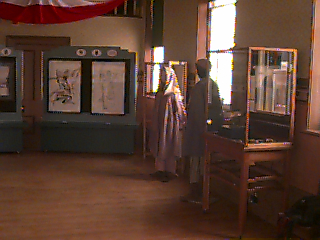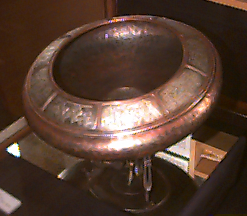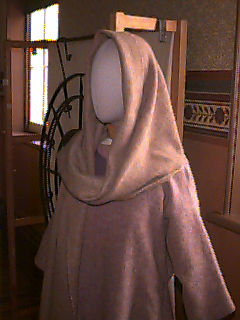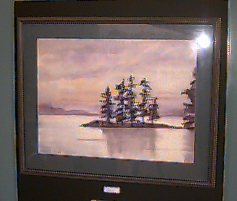



Lydia is an artist with a wide range of experience from design art through sculpture and art jeweler. In her work she uses organic materials, striped from detail forms and sculptural techniques. Recently her interest focused on projects which require extensive research on symbols and signs from different cultures. In her project 'Talismans' she approaches the subject of the use of lucky charms as a designer who is interested in the function of objects, and as an artist dedicated to the creation of aesthetic pleasing pieces for personal admiration. The result is a museum of luck-bringing objects always at hand in a place of honour at home.
"I have always been interested in the relation between Celtic and Thracian art as both cultures have tradition in working with metals and using zoomorphic imagery unique for the regions in which they have coexisted. My work is oriented towards studying symbols in ancient art forms and applying the information in modern forms of expression on the creation of objects for contemporary use"
Marin is a jeweler designer and goldsmith with experience in the field of restoration and conservation of metal museum objects. In his work he combines an extensive knowledge of precious metals with ancient techniques into an unique jeweler designs. His project 'Ancient Gold' incorporates knowledge of 5 b.c Thracian art and goldsmith techniques with his ideas for perfect adornment. The use of images in his work is inspired by the zoomorphic style, typical for the period. The technique of gold repousse is used as a pure gold sheet is raised into the desired relief reinforced and set in silver settings decorated with garnets, cornelians and pearls.
"Ancient metal art works have always fascinated me. In my work as a restorer for the National Institute for Cultural Heritage, Sofia, I have held many priceless samples of goldsmith mastery in need of repair - including works from the ' Gold of the Thracian Horsemen' exhibition shown in Palais de la Civilisation, Montreal '87. Working on these pieces has helped me to research various techniques and use them in the process of restoration and as a source of inspiration in the creation and production of my works."

"We are fascinated by the opportunity to explore the images and the story told in the Bayeux Tapestry and find important points to refer to in the building of the piece. The decision to make a cauldron comes from our interest in Celtic art and its influence on Western art forms manifested more clearly in the making of vessels for utilitarian or ritual purposes. A cauldron is a vessel for mixing wine, liquids or even concepts and thoughts . So we though that it will be the best shape to represent and symbolize the blend of cultures and rich mixture of styles from the period of time in which the Bayeux Tapestry was created."
The cauldron is made of raised copper with sculpted and cast legs and silver repousee on the top. The body is raised from one piece of copper and covered with border divided on nine sections in which a selected scenes from the Tapestry are rendered in silver repousee. The support of the vessel consist of tree horses in geometric style holding a rim underneath the vessel. The horses are sculpted from clay and cast from bronze and copper alloy using methods of lost wax casting. The nine silver repousse scenes are raised from pure silver, reinforced and set in the copper frames on the top of the vessel. There is also a silver repousse medallion set in the bottom of the cauldron.
Jo has been interested in sewing since making dolls clothes with her grandmother at the age of seven. Her interests turned to historical clothing in 1992 after attending a medieval New Years feast. She concentrates mainly on English costume of the working people from the 10th to 16th centuries. In 1994 she first took part in a Tudor Recreation at Kentwell Hall in Sulfolk, England and learnt natural dyeing techniques and began an appreciation for authentic colours in fabric choice. More recently her fascination with textiles has extended to weaving using either modern looms and fibres or the Dark Age style of the warp weighted loom.
Linen undertunic, short wool overtunic, wool coat trimmed with silk, Thorsberg pants made of cotton fibre, but in a period twill weave as might have been worn by Norsemen at about the time of the Conquest.

Long linen undertunic, short wool overtunic, with trim on the cuff inspired by tablet weaving of the period but woven in cotton using a modern 4-harness loom, and a wool headrail woven in 1-2 twill using a warp weight loom.
For the last 10 years , Marcus has been involved in the amateur reproduction and testing of historical artifacts from various parts of the medieval era. During this time he has participated in "living history" re-creations located on both sides of the Atlantic and covering themes that have ranged from 10th century Scandinavia to 14th and/or 16th century England. In 2000, his leather work was included in the 'Vikings - North Atlantic Saga' exhibit at the Denver Museum of Nature and Science. A scientist by training, Marcus is most interested in the functional simplicity and wear patterns of historical pieces, leading to simple, but robust items.
Styled after early 12th century ankle boots found in Billingsgate, London. Made in the turnshoe style and fastened with a drawstring that wraps around the ankle. Although the style is similar to that worn at the time of the Conquest , the rounded heel is a newer style that replaced the V-shape that predominated in earlier English and Norse communities.
Styled after 10th to 11th century boots of Norse construction similar to those that may have been worn by Normans. Unlike the women's boots they are made of a single piece of leather with a central, front seam and the sole is brought up to a V-shape at the heel.
As a Professor of French Literature at the University of Waterloo for 30 years, Raymond Dugan had many trips to France and visited Bayeux on numerous occasions. He became interested in the Tapestry as a result of purchasing a kit from the Bayeux Tapestry Museum gift shop, and decided to embark on an accurate reproduction of a larger piece of the original as an ongoing pastime. As a result of a major tragedy in his family in 1993, the loss of his two sons in a drowning accident, the completion of the Tapestry became a work of emotional therapy. It is dedicated to the memory of Andrew and Mark Dugan.
This loss has continued to be associated with the Tapestry in Dr. Dugan's life, and the works that he has produced, while not graphically tied to the Tapestry, are nevertheless emotionally connected with it. Both in drawings of the human figure and in watercolour landscapes he has tried to recapture some of the feelings associated in his life with the creation of the Bayeux Tapestry. (Raymond's reproduction of the Bayeux Tapestry inspired this exhibit.)
As the Tapestry narrates a profoundly human experience of death and disaster, this drawing draws from a related life story.
The violence and death in the Bayeux Tapestry concludes in the artist's version with victory and success. It is from that feeling that this drawing finds its inspiration.

The colours used are reminiscent of the Tapestry. As the Tapestry brought peace to the artist, the creation of this scene also gave the same feeling.